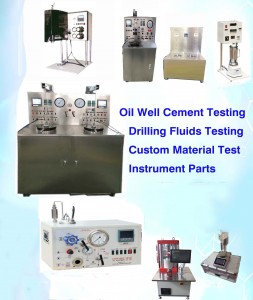Thickening time (also called pumping time) testing should be performed at the estimated bottom hole or treatment depth temperature and pressure using a HTHP consistometer.
- Test temperature considerations
- For primary cementing job, casing/liner cementing and cement plugs, the highest circulating hole temperature should be used for the thickening time test. The preferred method to determine the BHCT is with computer simulation software (data acquisition software is equipped with pressurized consistometer).
- For remedial/squeeze cementing the test temperature can generally be determined using the API correlation/tables in the API RP 10B-2 / ISO 10426-2. However, anytime the configuration of pipe size, depth and displacement rate/time does not correspond to API schedules, job-specific customized test temperatures and schedules based on actual job parameters and thermal computer models should be applied.
- When squeezing in production and injection wells, if accurate recent downhole (log) temperature data is available; this is used as the input parameter for modeling the squeeze test temperature.
- For coiled tubing operations, hole static temperature at the treatment depth (known geothermal gradient or recent logged temperature) should be used.
- Thickening (pumping) time requirement considerations
- For casing/liner cementing and plug cementing (except when using coiled tubing) the pumping time is estimated as the total operational time (including mixing and pumping cement, displacement, static periods like dropping wiper plugs or pulling out the cementing string, circulation of excess cement in liner cementing and cement plugs, etc.) Plus a safety factor of no less than two (2) hours.
- Thickening time tests for particular cases, such as liner cementing, cement plugs or two-stage cementing, should consider the need of a static time (no rotation in the consistometer for a small period) to identify any gelling tendency in the cement slurry in actual conditions, like before/during POOH drill pipe or before circulating excess cement.
- For casing/liner cementing and plug cementing (except when using coiled tubing) the pumping time is estimated as the total operational time (including mixing and pumping cement, displacement, static periods like dropping wiper plugs or pulling out the cementing string, circulation of excess cement in liner cementing and cement plugs, etc.) Plus a safety factor of no less than two (2) hours.
Thickening Time should be no more than is needed to place the slurry while allowing for contingencies safely. Shorter times increase risk. Avoid longer times because they are subject to increased measurement error and uncertainty.
- For remedial/squeeze cementing (except when using coiled tubing), pumping times should be long enough to allow the cement slurry to travel to the placement depth. Then the injection of the cement slurry (cement slurry volume at the anticipated injection rate) to the target zone. Time is also allowed for repeated squeeze-hesitation cycles. Then we allow time to reverse or direct circulate any excess cement out of the well (if this is planned). The following should be considered:
- A minimum safety margin of two (2) hours is recommended.
- When testing the slurry for a hesitation squeeze, it is recommended to simulate the shutdown times in the laboratory during testing of the cement slurry.
- An additional safety factor should be considered for circulation squeeze. In these operations, the actual thickening time is typically reduced and the gel strength development considerably accelerated due to the loss of filtrate while the cement slurry flows under pressure behind the casing between the perforations.
- For coiled tubing cementing we recommend a minimum thickening time of 8 hours.
- For laboratory testing, actual field mixing and pumping conditions should be reproduced by the cementing contractor considering the following:
- Additional mixing energy imparted to the cement slurry in actual conditions (batch-mixing of a relatively small cement volume and the high friction pressure inside the coil) makes the API mixing procedure described in API RP 10B-2 / ISO 10426-2 section 5 insufficient.
- The thickening time for a cement slurry mixed according to API mixing procedures may be reduced up to 75% in coiled tubing cementing.

- For laboratory testing, actual field mixing and pumping conditions should be reproduced by the cementing contractor considering the following:
Post time: Apr-08-2022